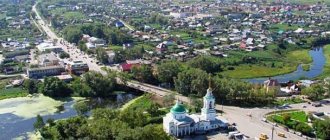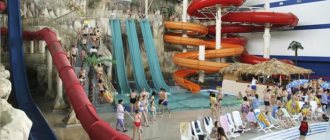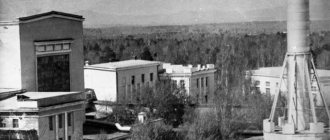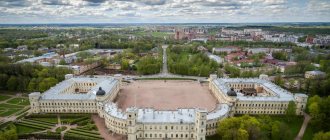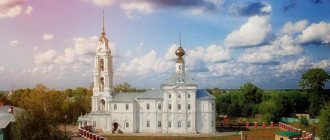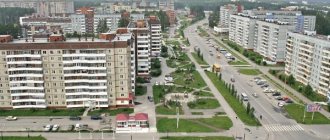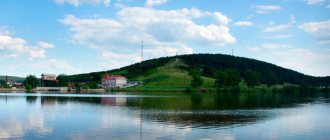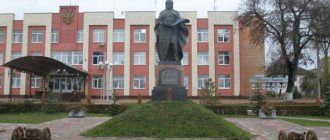Zarechny is one of the youngest cities in the Sverdlovsk region. It appeared thanks to the development of nuclear energy. In 1954, 15 kilometers from the village of Beloyarsky, it was decided to build a thermal power plant. On July 2, 1955, a document was issued on the allocation of land for the construction site of the Beloyarsk power plant. It was an All-Union Komsomol construction project. The first builders arrived in September 1955 from Ukraine - from the Zhitomir, Dnepropetrovsk and Poltava regions. Gradually the number of builders grew, and Leningraders also arrived.
The residents themselves called the construction village that appeared Lesnoy. However, such a settlement already existed in the region, so by decision of the Sverdlovsk Regional Executive Committee on October 1, 1957, the village of Zarechny, Beloyarsk District, was formed.
In 1957, the government decided to build a nuclear power plant instead of a thermal power plant. The BNPP was designed with a capacity of 400 thousand kW/hour and was intended to cover the power shortage in the Sverdlovsk energy system, as well as for experimental work. BNPP became the second industrial nuclear power plant in the Soviet Union (after Obninsk). In 1960, the nuclear power plant under construction was named after I.V. Kurchatova.
To cool the reactors, a huge Beloyarsk reservoir was built. In 1963, a reactor with a capacity of 100 thousand kWh/hour was built. On July 15, 1963, the physical start-up of the reactor took place, and on April 26, 1964, the power start-up took place. On December 29, 1967, the second reactor was launched, and current began flowing into the Sverdlovenergo system. The third power unit BN-600 with a fast neutron reactor was launched on April 8, 1980.
At the same time, the population center grew. On September 7, 1992, the working village of Zarechny received the status of a city of regional subordination.
Recently, a new, fourth, power unit of the BNPP was launched. As of 2022, more than 27 thousand people live in the city.
The main attractions of the city are the Beloyarskoye Reservoir and Aleshchenkova Boulevard.
The Beloyarsk reservoir is most picturesque in the area of the dam. Beautiful rocks rise above the Pyshma River. There is good fishing on the pond itself.
Aleshchenkov Boulevard is the local Arbat, a pedestrian street. The boulevard is named in memory of one of the founders of domestic nuclear energy, a participant in the construction of the first and second reactors of the Beloyarsk Nuclear Power Plant - scientist and designer Pyotr Ivanovich Aleshchenkov. He lived in Zarechny from 1962 to 1967.
Its own pedestrian street in Zarechny was opened in 2011. Paths for pedestrians are paved with tiles, benches are placed, flower beds are laid out, trees are planted, a rotunda and small architectural forms are installed. In particular, here you can see the bronze sculpture “Lovers” (sculptor Igor Akimov). Walking here is a pleasure. The boulevard has been improved with funds from BNPP. Although, according to many townspeople, it would be better to build an embankment on the shore of the Beloyarsk reservoir. There is no embankment in Zarechny.
Zarechny also has its own local history museum. It is located on Ostrovsky Street, 6. Telephone +7 (34377) 7-34-07. Website https://www.zar-museum.ru. Working hours: Mon-Fri 10:00-19:00, Sat, Sun – closed. The museum was created in 2000 and occupies the premises of a former kindergarten. Has three exhibition halls.
Nowadays, despite the proximity of the nuclear power plant, you can get into the city freely; it is not “closed”.
Beloyarsk nuclear power plant
We will begin our journey with an acquaintance with the city-forming enterprise - the Beloyarsk NPP. On February 11, 1960, the Central Committee of the CPSU and the Council of Ministers of the USSR issued a decree naming the BNPP after I.V. Kurchatov. A meeting was held at the station, at which builders and installers assured that they would bear his name with honor. On April 20, 1969, a bas-relief of Kurchatov, a scientist, statesman, three times Hero of Socialist Labor, laureate of the State and Lenin Prizes, was unveiled at the BNPP. Igor Vasilyevich headed the country’s atomic science. Under his leadership, the project of our station was created. And on the day of the opening of the bas-relief, at the request of BNPP, it was decided to name one of the streets of Zarechny Kurchatov Avenue. Both stages of the BNPP are unique and are based on different principles of operation: the first consists of two blocks with water-graphite channel nuclear reactors with a total design power of 300 mgW, and the second stage (EB No. 3) with a fast neutron reactor with a power of 600 mgW. Power units No. 1 and No. 2 were stopped in 1981 and 1989, respectively, after exhausting their resources, producing more than 30 billion kW. Power unit No. 3 is the world's largest operating power plant with a fast neutron reactor and is included in the Sverdlovenergo network. It has an integral layout, where all the main equipment of the 1st circuit and a high radioactive environment is located inside the reactor vessel, which significantly increases the radiation and nuclear safety of the installation.
The referendum on the municipal formation took place on April 14, 1996, and on December 17, 1996, the Decree of the Governor of the Sverdlovsk Region “On inclusion in the register of municipal formations” of the municipal formation “Zarechny City” was signed.
On November 23, 2005, the Certificate of the Main Directorate of the Ministry of Justice of the Russian Federation for the Ural Federal District “On the inclusion of the municipal formation of the Zarechny Urban District in the state register of municipal formations” was signed.
The municipal formation includes the city of Zarechny itself and 4 settlements: the village of Mezenskoye, the villages of Gagarka, Boyarka and Kurmanka. The center of the municipal formation is the city of Zarechny, Sverdlovsk region. The distance from the center of the municipality to Yekaterinburg is 60 km.
The village of Zarechny was created as part of the state program for the development of nuclear energy, as one of its bases. Thus, the history of Zarechny is inextricably linked with the history of the nuclear power plant.
On June 9, 1954, the Ministry of Power Plants approved the task for the construction of a thermal power plant 15 km from the regional center of Beloyarsk.
The first document, a kind of birth certificate for Zarechny, was the Order of the Council of Ministers of the USSR dated July 2, 1955 on the allocation of land for a construction site.
By order of the Ministry of Construction of Power Plants N 163/a dated August 16, 1955, Glavenergostroy was instructed to organize the construction department of the Beloyarsk power plant in the third quarter of 1955 as part of the Uralenergostroy trust. The construction was declared an All-Union Komsomol construction project.
The first group of builders - 753 people - arrived on September 6, 1955 from the Zhitomir, Dnepropetrovsk and Poltava regions. In the fall of 1956, 394 Leningraders arrived on Komsomol vouchers. By the end of 1957, there were already 2,406 people working on construction.
The village that arose during the construction of the Beloyarsk State District Power Plant was called Lesnaya by the first builders themselves. However, the settlement of Lesnoy was already in the Sverdlovsk region and by decision of the Sverdlovsk Regional Executive Committee No. 652 of October 1, 1957. The Zarechny Village Council of Workers' Deputies of the Beloyarsk District of the Sverdlovsk Region was formed. Consequently, the village itself was classified as a workers’ settlement and became known as the village of Zarechny, Beloyarsk district, Sverdlovsk region. The Zarechny working village includes the villages of the factory named after. Comintern, tool plant, Melzavod N 5, pos. Sheelit and the Muranitny railway crossing.
Subsequently, when the village of Beloyarskoye was classified as a working settlement, by the decision of the regional Executive Committee of August 14, 1959. The following were excluded from the village of Zarechny: Comintern Factory, Tool Plant, Mill Plant No. 5.
Thus, until 1992, the Zarechny Village Council included the settlement of geophysicists Sheelit, the village of Muranitny with a railway station and the territory of Zarechny itself.
In 1957, the party and government made a new decision to build a nuclear power plant in the Beloyarsk region.
The technical design of the Beloyarsk NPP was developed on the basis of a design assignment completed by the Leningrad branch of Teploelektroproekt with the participation of the Leningrad Polytechnic Institute. On July 15, 1957, it was approved by the board of the Ministry of Power Plants.
The BNPP was designed with a capacity of 400 thousand kW/hour and was intended to cover the power shortage in the Sverdlovsk energy system and for experimental work. The technical design provided for the possibility of expanding the power plant to 1,200 thousand kW/hour.
Since 1956, work has been carried out on the construction of a waterworks. To cool the nuclear reactor of the future power plant, a colossal amount of water was required, so it was decided to build a dam 260 m long and 22 m high in the canyon of the Pyshma River. By the time the station was launched, the area of the reservoir was supposed to be 40 square meters. km. It was necessary to blow up rocks, dig a pit, and erect a concrete spillway. In 1958 Pyshna was blocked by a dam, and on March 14, 1961, the hydroelectric complex was put into operation. It took six years to create the Beloyarsk Reservoir - the main attraction of Zarechny - a place of recreation, hunting, fishing, and tourism for many residents of the Sverdlovsk region.
On May 20, 1958, the foundation of the main station building was laid.
BNPP is the second industrial nuclear power plant in the country. The first in Russia and in the world was Obninskaya. The Beloyarsk NPP project was created under the supervision of Igor Vasilyevich Kurchatov. In 1960, during the height of construction work, the sad news came that the wonderful scientist had died. The Central Committee of the CPSU and the Council of Ministers issued a Decree on naming the BNPP after Kurchatov on February 11, 1960. The builders and installers decided to bear this name with honor.
In 1963, the construction of a reactor with a capacity of 100 thousand kW/hour was completed. Operators, physicists, heating engineers, instrument engineers and other energy specialists came into their own. On July 15, the physical start-up of the reactor took place, and on April 26, 1964, the power start-up took place.
In December 1967, construction and installation work on block II was completed. On December 29 at 14:05 the start-up of the BNPP reactor II took place. The current entered the Sverdlovenergo system. Changing the design of the technological channels made it possible to increase the volume of heat from the “nuclear furnace” - the power of the second block was twice that of the first of the same design.
On April 8, 1980, the third power unit of the BNPP - BN-600 - was launched - the second unit in the country with a fast neutron reactor. At the ceremonial meeting dedicated to the launch, the then first secretary of the Regional Committee of the CPSU B.N. Yeltsin was present. On October 4, the team of builders and operators of the BNPP was awarded the Order of the Red Banner of Labor.
Since 1976, Beloyarsk NPP has annually presented its exhibits at VDNKh. Many of them received high praise.
Currently, intensive work is underway to create an innovative project for the 4th power unit BN-800 with a fast neutron reactor; the commissioning of the power unit will allow us to approach the implementation of the basic idea of creating power units with fast neutrons and implementing a nuclear closed fuel cycle.
By the beginning of 1992, the population of the village of Zarechny was about 28 thousand people. In the village there is a large enterprise - the Beloyarsk nuclear power plant named after. I. V. Kurchatova, construction department, environmental station of the UC, Branch of the Uralobuv factory, nylon twine workshop, Bazhenov geophysical expedition, there were four secondary schools, an evening school for working youth, a music school, an energy technical school, 14 preschool institutions, medical sanitary unit, trade and catering enterprises, consumer services and other organizations.
By this time, Zarechny had outgrown the boundaries of the village. In order to create conditions for the development of knowledge-intensive, world-class competitive industries, the formation of a center that generates innovations and introduces them into production, using the potential of “closed” enterprises and territories, attracting foreign investment and technology for a comprehensive solution to the problems of the agricultural sector and the social renewal of the countryside, as well as In order to develop economic mechanisms for the adaptation of small towns and enterprises, high-tech industries to market conditions, the Economic Council under the Head of the Administration of the Sverdlovsk Region on April 23, 1992 approved the project to create the Zarechny Technoagropolis in the Sverdlovsk Region.
By Decree of the Presidium of the Supreme Council of the Russian Federation of September 7, 1992 N 3472-1, the working village of Zarechny, Beloyarsk district, Sverdlovsk region, was classified as a city of regional subordination.
The city of Zarechny differs from many other cities of the Sverdlovsk region in its scientific-experimental and scientific-production profile. A unique scientific base has been created in Zarechny, ensuring the development of materials, technologies, instruments for nuclear energy technologies, with the corresponding scientific and technical infrastructure. This specificity forced us to look for unconventional methods, new areas of application of labor during the period of a sharp reduction in the state’s interest in nuclear energy, and then economic reforms and conversion, and a general socio-economic crisis.
At the beginning of 1996, the city administration’s Action Program was adopted to strengthen state power and reform the territory’s economy, the goal of which is to create the preconditions for a sustainable improvement in the quality of life of the population. The implementation of the planned measures made it possible to create the preconditions for a gradual slowdown in the decline in production and some revival of investment activity.
In 1996, the first stage of the creation of TNPK Technopolis Zarechny, associated with the creation of a regional center for scientific and technical innovation, was completed, and the implementation of production and infrastructure projects continued. At the same time, it was possible to preserve the scientific and production potential concentrated in the city of Zarechny, preserve the social infrastructure and practically re-create the business infrastructure. Currently, the city is undergoing structural restructuring of the economy. Proof of this are the following facts:
- the conversion of the SF NIKIET led to a decrease in the share of defense orders from 90% to 10% and to the emergence of about a dozen whose products are successfully sold on world markets (isotopes, laser devices, pure gases, sorbents);
- diversification of city-forming enterprises made it possible to create new industries (production of heat exchangers, production of sorbents, production of telephone sets);
- support for small businesses in the field of high technology has led to the emergence and rapid development of small businesses (production of calibration gas mixtures, regeneration of motor oils, provision of telecommunications services);
- the development of social and business infrastructure brought new production to the territory, created entirely at the expense of the project authors (production of shoe polish and paint, joint venture for the production of footwear, production of ultrasonic scanners).
The priority areas for the development of the Zarechny urban district as a territory (zone) of priority development are the following areas of activity:
- Development of nuclear energy with fast neutron reactors (the first priority is the implementation of a promising innovative project - the construction of the fourth power unit with a BN-800 reactor, with a capacity of 880 MW).
- Development of innovative knowledge-intensive industries that are significant for the implementation of both national priority projects, as well as the development of the innovative sector of the economy.
- Development of high-tech technologies of “nuclear medicine”, its therapeutic and diagnostic areas, significant for solving medical and demographic problems of the territories and the Sverdlovsk region and Urfa as a whole (the implementation of this direction is carried out jointly by the city of Zarechny and the city of Yekaterinburg).
A gold deposit was discovered on the territory of the municipality, half of the production of which, according to the Decrees of the President of the Russian Federation, is allowed to be used as collateral for guarantees to investors participating in the financing of the Program projects, including the project for the construction of the BN-800 power unit.
The dominant industry in the city is nuclear energy. The main enterprises belong to the Russian Ministry of Atomic Energy or are related to nuclear energy and industry:
- State enterprise Beloyarsk NPP - electricity, nuclear fuel production;
- Institute of Reactor Materials - isotopes, control and inspection of materials of nuclear power plants;
- Beloyarsk installation department of JSC "Trest Uralenergonontazh" - "Forgo" type heat exchangers for dry cooling towers, general and special installation work;
- Beloyarsk building structures plant CJSC "Uralenergostroy" - building parts and structures;
- Kurmansky stone and gravel quarry of JSC "Uralnerud" - high-quality crushed stone and sand;
- Atomenergoremont—repair of power equipment of nuclear power plants.
Scientific institutions of Zarechny are represented by branches of the UroRAN, divisions and subsidiaries of the Research and Design Institute of Energy Engineering, which are city-forming and conduct active economic activities.
In enterprises and departments located in the city and related to scientific and technical activities (Thermoxide, IRM, Department of the Institute of Metal Physics of the Ural Branch of the Russian Academy of Sciences, Biological Station of the Institute of Plant and Animal Ecology of the Ural Branch of the Russian Academy of Sciences, Bazhenov Geophysical Expedition; PGS-Service LLC, etc. ) there are 10 Doctors of Science, 48 Candidates of Science, and about 500 researchers.
In the village of Sheelit, part of the city of Zarechny, the Bazhenov expedition of the State Committee for Mineral Resources of Russia is located. As a result of a systematic geological study of the territory of the municipality, deposits of precious and ornamental stones were discovered here: rhodonite, amethysts, beryls, emeralds.
In Zarechny, gold is mined and processed, and the Kurman deposit of building stone is exploited.
Main activities in the territory: electricity production, construction and installation services, production of building materials, production of agricultural products, mining and processing of non-metallic building materials.
The agricultural sector of the Zarechny municipality is represented by: Agro-industrial complex “Mezenskoe”, farms.
Public organizations and associations are active, including organizations of disabled people, veterans, refugees and internally displaced persons, victims of political repression, liquidators of the consequences of the Chernobyl accident and others. An invaluable role in organizing work on the patriotic education of the younger generation belongs to the City Council of Veterans, which is headed by a war veteran, retired major Ivan Alekseevich Sedinkin. Zarechny is a young city... When the great battle raged in the West, the taiga was noisy in this place, and the mail did not bring funerals here from the fronts. Therefore, in Zarechny there are no obelisks with the names of those who fell on the battlefield carved, but the memory of the hard times of war lives in the hearts of its inhabitants. The city has Victory Square, on which a stele was erected in honor of the soldiers and home front workers who defeated fascism. On days of celebration, an eternal flame lights up at this monument. And this is no coincidence. After all, among the first builders there were many WWII participants who came upon conscription to the All-Russian Komsomol construction site and stayed here forever. The city of Zarechny became home to them. It also became the second home for Hero of the Soviet Union N.M. Grigoriev. and for the Hero of Socialist Labor Ivan Nikolaevich Osintsev.
However, other, undeclared wars have affected our small city with their black wing. Evgeniy Vlasovich Grishkin and Andrei Vladimirovich Zaikov died in the Afghan war, the lives of Rinat Zinurovich Muhibulin and Daniil Vladimirovich Sultanov were taken away by Chechnya... A complex attitude develops towards these wars. Time will set its own accents, and the memory of the guys will forever remain in our hearts.
Today, 759 enterprises are registered in the city, of which 14 are joint ventures with the involvement of foreign capital. Main activities in the territory: electricity production, construction and installation services, production of building materials, production of agricultural products, mining and processing of non-metallic building materials. The city traditionally has extensive international and interregional connections. They are determined by the specifics of industries located on the territory and are mainly of a production or scientific nature. First of all, these are connections with the cities of the former USSR, in which nuclear engineering and nuclear fuel cycle enterprises are located; scientific centers; all cities near nuclear power plants. A similar circle of connections exists with countries “far” abroad. First of all, these are American energy and nuclear industry research centers, nuclear centers in France and Japan, and research centers in Germany and Denmark. Production and industry ties are complemented by socio-economic ones. Previously, Zarechny's sister city was the uranium center in Czechoslovakia - Tachov. Currently, connections have been established with scientific and technical innovation centers (technopolises) in Germany, Japan, and the USA. Several scientific and socio-economic programs are being conducted. A marketing center has been created and the work of the Technopark is financed with funds from the US Agency for International Development.
Currently, the city has a developed social infrastructure: there are branches of 5 banks, the city population is served by 202 trade facilities, 34 facilities operate in the public catering sector, 82 business entities (65 facilities) provide 16 types of personal services to residents. Restaurants, hotels, cafes, canteens, pharmacies, hairdressers, studios offer their services to residents and guests of the city. There are 8 mini-workshops for the production of consumer goods, including 3 for the production of food products.
The city newspaper “Pyatnitsa”, the city television center, the weekly newspapers “Zarechenskaya Yarmarka”, “Domashnyaya Gazeta”, “Pyatnitsa-PRO” promptly provide information to the population of the city and rural areas.
The organizational work of the city administration, cooperation with the City Duma, with economic entities and with the city-forming enterprise, interaction with the executive authorities of the Sverdlovsk region made it possible to consolidate the positive trends that have developed in the territory since 2003.
The Regional Government has determined an assessment of the competitiveness potential of the region's municipalities.
The number of employees at city-forming enterprises is about 3.2 thousand people (BNPP-2632 people and IRM-526 people); About 2 thousand people work in the public sector.
In accordance with the decision of the Small Council of the Sverdlovsk Regional Council of People's Deputies dated June 23, 1993 N 153/21, the Mezen Village Council was transferred to the city of Zarechny under administrative-territorial subordination. Thus, “is the territory of the city proper and four rural settlements, within which local self-government is exercised.
The oldest settlement in the municipality is the village of Mezenskoye, founded around 1612.
The social infrastructure of the rural area includes: 2 schools, 2 kindergartens, ZMU TsKDS "Romantic" with three branches, 3 rural libraries, 4 first aid stations. In 1999, work was carried out to improve water supply in the village (a water tower was installed and a reserve well was drilled). Back in 1996 Funds were received from the regional Financial Administration for radical land improvement, anti-leukemia measures, subsidies for produced and sold agricultural products, as well as for support of elite seed production and selective breeding livestock. The main goal of the work of rural and urban administrations in relation to the village is to equalize the everyday and cultural level of rural and urban residents. In the municipality of Zarechny City, all medical care is provided by a hospital with 230 beds and a polyclinic department with 640 visits per shift (MSCh-32). The priority areas of healthcare are the protection of motherhood and childhood, the reduction of child and, in particular, infant mortality and morbidity, and the provision of medical and medicinal care to the population. According to the territorial compulsory health insurance program, the local budget bears the costs of treating socially significant diseases, such as diabetes, tuberculosis, drug addiction and mental disorders.
According to the rating based on the results of socio-economic development in 2006-2007. the territory is in the top ten among 68 urban districts of the Sverdlovsk region, and according to the competitiveness potential rating, the city district ranks 1st in terms of labor potential and entrepreneurial activity.
Monument to War Heroes
Having covered the three-kilometer distance that is part of the sanitary protection zone of the nuclear power plant, we enter the central square of the city - Victory Square. In 1965, in connection with the celebration of the 20th anniversary of Victory in the Great Patriotic War, by decision of the Executive Committee of the Zarechny Council No. 6, Narodnaya Street was renamed 9 May Street, and the square on Lenin Street was named Victory Square. We draw attention to the monument in honor of our fellow countrymen - war heroes. It was created at the request of residents of the working-class village of Zarechny. The foundation stone for the monument was laid on May 9, 1976, and it was built with funds from the Belorussian Nuclear Power Plant. The author of the project is V.N. Yutkin, the artist of the embossed canvases is A.N. Bersenev. The opening of the monument took place on November 7, 1977. A delegation of guests from Czechoslovakia attended the solemn meeting. There was a park with blue spruce trees near the monument. The monument is a rectangular pillar 8 meters high on a base lined with marble. There are 3 metal cubes of different sizes on the post: two on the front side and one on the back. The bas-relief on the lower cube of the obverse depicts a worker with a hammer and a soldier holding a sword. On the upper cube of the back side of the pillar there is a bas-relief stylized image of a flame. On the base of the monument is the Eternal Flame. On celebration days, almost the entire city gathers here, the newlyweds lay bouquets of flowers at the foot, and on weekdays people like to sit on the benches in the alley and admire the stunning flowers growing in the flower beds.
About the municipality
The urban district of Zarechny unites: the city of Zarechny, the village of Mezenskoye, the villages of Gagarka, Boyarka and Kurmanka; is located in the Middle Urals, in the southern part of the Sverdlovsk region. and covers an area of 29,927 hectares. The oldest settlement in the district is the village. Mezenskoe, founded in 1612. The Zarechny urban district runs through:
- Federal highway: Yekaterinburg - Tyumen;
— highway of regional significance: Yekaterinburg - Tyumen - Studenchesky village - Bolshiye Brusyany village;
— local roads: Mezenskoye village – Kurmanka village – Boyarka village; Mezenskoe village - Kurmanka village - Boyarka village - Bazhenovo sanatorium; Mezenskoye village – Zarechny town; Boyarka village - waterworks of the Beloyarsk reservoir; Mezenskoye village - Bazhenovo station;
Railways: Ekaterinburg - Tyumen; Bazheno station - Asbest town; junction Mezensky - Kurmanka village.
The territory of the municipality is confined to the junction zone of the mountainous part of the Urals and the West Siberian Lowland, is homogeneous in zonal terms and is located in the southern subzone of the taiga.
According to geological data, deposits of the Middle Paleozoic and various intrusive and subvolcanic complexes of the Middle-Late Paleozoic are developed on the surface, and only in the extreme western part do formations of the Late Proterozoic emerge on the surface. The geological exposure of the territory is poor; areas where bedrock is found can be traced along the banks of the river. Pyshma. The height of the rocky outcrops reaches 10-30 meters.
In the western part of the territory there is a hilly ridge topography with elevations of 200-250 m.
The eastern part is a typical slightly hilly plain. On the surface of the bedrock, alluvial deposits are widely developed, overlain by clayey sediments. Alluvial deposits are developed in river valleys. Peat, loam, sandy loam and gravel are common. The territory is dominated by brown forest soils of varying degrees of turf and peaty. The soils are slightly acidic, the humus content is 7-15%.
Hydrogeologically, the territory is located within the Tobolsk artesian basin. The hydronetwork is formed by the Pyshma River with small tributaries (Kamyshenka River, Mezenka River, Kamenka River), which is part of the Tura River basin. The bed of the Pyshma River is moderately winding, ranging from 5 to 40 meters wide. The river is calm, the current speed is about 0.3 m/sec.
In the northwestern part there is a large Beloyarsk reservoir with an area of 37.1 sq. km. The climate is temperate continental, temperatures range from -40 in winter to +37 in summer. The area covered with forest is 16,025 hectares, the main species are: pine, birch, aspen, linden.
There are 15 mineral deposits on the territory, of which significant ones are: Gagarskoye gold ore deposit, Kurmanskoye granite deposit, groundwater deposit, semi-precious stone raw materials, etc.
According to climatic conditions, the territory belongs to the temperate continental type. The ambient air temperature varies from -46? With winter up to +37? Happy summer. Winter is cold and long, with snow cover lasting from October to April. Cover thickness is from 0.5 to 0.8 m. Soil freezing is up to 1.5 m. The territory belongs to a zone of sufficient moisture. The prevailing winds are northwest, west and southwest.
In the local forests there are various medicinal plants, St. John's wort, meadowsweet, rosemary, capillary, cinquefoil erect, blueberries, strawberries, raspberries, etc. Among the rare plants listed in the regional Red Book, we can note: spotted lady's slipper, spring adonis, curly lily, creeping thyme and some others. All of them are also medicinal plants, and therefore require special protection.
The fauna of the territory is typical for the southern taiga subzone of the Ural region, however, it is significantly depleted in species composition. The reason for this is the close proximity of large industrial centers and transport accessibility. Among the ungulates, elk is ubiquitous here, which has recently begun to intensively damage pine forest crops, which indicates the need to develop measures to regulate the number of this species. The mountain hare, squirrel, mole, marten, mink and other species are also found here. Pollution of the natural environment of the municipality with man-made products occurs mainly due to industrial enterprises located within a radius of 50 km from the city of Zarechny and agricultural production facilities. Surface and partially underground waters, as well as atmospheric air, are subject to especially significant anthropogenic load. The value of a number of chemical substances exceeds the maximum permissible concentrations.
This territory belongs to the III zone of air pollution potential; in general, it is influenced by emissions into the atmosphere from numerous enterprises of the cities: Yekaterinburg, Verkhnyaya Pyshny, Berezovsky, Asbest, etc. However, the level of air pollution within this zone is heterogeneous. The influence of these sources is weakened due to distance and the protective effect of forests.
Favorable climatic and forest conditions, as well as the peculiarities of the hydrological regime, allow the use of this territory for recreational purposes for the majority of the population not only of the urban district of Zarechny, but also of other cities of the Urals.
Obelisk in honor of the first builders of the city
And now let’s turn to another monument - an obelisk dedicated to the first builders of the Belorussia NPP and Zarechny. Its opening took place on August 6, Builder's Day. Builders, veterans and those who are currently building Unit 4 of the BNPP gathered for the celebration. Opening the monument, BNPP Director V.D. Infantiev emphasized that the new monument is a tribute to the pioneer builders of Zarechny, an order to new builders to continue their work with dignity. We owe the appearance of another attraction to a very large number of people. The places where the monument is installed are decorated with polished red and black granite. Nearby are decorative lanterns and benches. After the ceremony, many took photographs as a souvenir with the lines carved on stone: “There are many different cities in the world, but we built this one ourselves.”
Monument to the "Best Soldier in the World"
We are approaching another landmark of the city that appeared not so long ago. Everyone here knows about the existence of the Paratrooper club. Over the 20 years that it has existed, more than one hundred boys and girls have become its graduates. It all started in April 1986, when Afghan war veteran Oleko Atuevich Kairbekov gathered around him several boys who learned hand-to-hand combat techniques and studied weapons. Now the club is headed by Valery Yurievich Bubnov. On his initiative, the club was named after Nikolai Chepik, a paratrooper who died in Afghanistan, who blew himself up while covering the withdrawal of his platoon. For this feat he was awarded the title of Hero of the Soviet Union. Former Paratrooper cadets served in almost all branches of the military, many forever linked their lives with the army. Opposite the club in 2004, a monument to the “Best Soldier in the World” was unveiled, which is a BMD erected on a pedestal. It is noteworthy that it was created through the efforts of the people, the efforts of the club’s students, literally from a picture drawn by a schoolboy with watercolors.
Beloyarsk Reservoir
The next most picturesque place in Zarechny is the dam of the Beloyarsk Reservoir. Here in 1965, work began on the construction of a waterworks. The future power plant needed a colossal amount of water, so a dam was built in the canyon of the Pyshma River. Work was carried out to excavate soft soil under the foundation pit to cover the dam. It was necessary to blast rocks to expand the river alignment. The construction teams - concrete workers Nikolai Kakhno, Leonid Bender, Vasily Morozov - especially distinguished themselves. The reservoir itself was formed by regulating the Pyshma riverbed 75 km from its source. The river belongs to the Ob-Irtysh basin and is a right tributary of the river. Tours. The source of the Pyshma River is Lake Klyuchevskoye. The flood zone includes part of the territory of the Beloyarsk region, mainly covered with mixed birch and pine forests. In addition, arable and meadow lands in the Beloyarsky and Berezovsky districts were flooded. The reservoir bed was prepared for flooding in the dam area. The length of the reservoir is about 20 kilometers, the width at the level of the BNPP is about 3 kilometers. The surface area of the reservoir is 47 square kilometers. The rivers Pushkarikha, Cheremshanka, Chernaya, and Marya flow into the reservoir. The reservoir is a favorite vacation spot for citizens and guests of the city, its main attraction. Along its banks there are many recreation centers, beaches, a boat station, and the Riviera recreation area. By the way, half a kilometer from the dam is the village of Boyarka, which is a unique archaeological site in Russia.
How to get to Zarechny?
By car from Yekaterinburg you need to take the road to Tyumen, then turn to Zarechny. Distance from Yekaterinburg – 60 km. Passenger buses run from Yekaterinburg to Zarechny.
Pavel Raspopov
UraloVed.ru
See also:
Closed cities of the Urals
Museums of the Sverdlovsk region (full list)
The city of Asbest, its history and attractions
Leningradskaya street
Leningradskaya Street stretches wide before us, which received its name on October 23, 1980 by decision of the Executive Committee No. 102 and taking into account the wishes of the workers. So, in memory of the 394 Leningraders who came in the fall of 1956 on Komsomol vouchers to conquer the taiga, the street - the line of the village of Lesnoy turned into an arrow-straight, spacious and bright street. Modern new buildings adorn it, and along its entire length there are untouched pine trees and meadows of meadow flowers. The Children's Art School, established in 1990, is comfortably located here. There are 300 children studying there, most of whom enter universities and art colleges. Educational work at school is aimed at enriching the spiritual potential of the individual. Children's Art School is a cultural and educational center at the regional level.
Museum of Mineralogy at Polyana Skazok
We enter the courtyard of school No. 1, where a stone-cutting workshop and a unique museum of mineralogy of the Urals are conveniently located. The museum staff conducts fascinating excursions showing crafts made from minerals that are rich in the Ural Mountains. But thanks to the caring and creative approach to the matter of the museum director A.N. Selivanov, the museum staff, the school yard was transformed and turned into a paradise. A stone slide with a water cascade, benches, and even cedar trees appeared here. A lantern decorated with wrought iron illuminates the paths lined with natural stone in the form of fish swimming towards each other. Stones with a polished cut that reveals the internal design are very attractive. In general, an exhibition of ornamental and semi-precious stones: jasper, beryl, quartzite - in nature. It is no coincidence that city residents have already called this place the Glade of Fairy Tales or the Field of Miracles.
Museum of Local Lore
We head further to the place where history lives.
On December 29, 2000, a local history museum was opened in the city. It has an exhibition hall for periodic exhibitions and two permanent exhibition halls: the Hall of Military and Labor Glory and the Hall of BNPP History - the history of the city. Veterans of the Great Patriotic War, home front workers, and labor veterans constantly gather in the Hall of Military and Labor Glory. Here, conversations are held with city schoolchildren about the exploits and heroic past of the residents. These meetings are timed to coincide with anniversaries and significant dates; veterans are awarded commemorative medals and certificates of honor in the hall. The exhibition “Countrymen of Zarechny in defense of the Motherland during the Great Patriotic War of 1941-1945” is on display in the hall; it is planned to create an exhibition “From the village of Lesnoy to the city of nuclear scientists of Zarechny.” [/td]
The city's attractions
Zarechny is a typical low-rise Russian town. Considering the history of its creation, it is not surprising that the main attractions of the city will be in one way or another connected with the Beloyarsk Nuclear Power Plant .
Beloyarsk Reservoir
The Beloyarsk reservoir is one of the most beautiful artificial reservoirs in the Sverdlovsk region . Looking at the water churning with waves, at the sandy shore, at the seagulls circling fishermen, it’s not difficult to decide that what you’re looking at is not a reservoir, but a real sea.
Local residents and city guests come here to relax, fry meat or fish. The latter, by the way, can be caught here in the reservoir - according to local fishermen, the bite here is good. The variety of aquatic inhabitants is also pleasing, among which you can find roach, bream, carp, pike, perch, pike perch, ruffe, burbot, tench and crucian carp.
On the shore of the Beloyarsk Reservoir there are also various recreation centers and boat stations.
However, there is another reason to visit this place - the dam. It is worth saying that without it, the reservoir itself would not have existed: the dam was installed for the operation of a nuclear power plant on the Pyshma River , as a result of which the Beloyarsk Reservoir . The dam is a protected site, so entry by car and photography and video shooting on it are prohibited. However, at any time you can walk along it and enjoy breathtaking views of forests, rocks and rushing waters, over which you can see a rainbow.
Read more
Aleshchenkov Boulevard
The boulevard is pedestrian, representing the local Arbat. The boulevard received its name in honor of the scientist and designer, one of the founders of domestic nuclear energy, Pyotr Ivanovich Aleshchenkov , who contributed to the construction of the first and second BNPP .
The boulevard began its work in 2011. Here you can find all the amenities necessary for such a place - tiled paths, benches, a rotunda, various sculptures. One of the most famous is the bronze sculpture “Lovers” . It's really nice to walk here among the flower beds and trees.
The presence of this landmark in the city is also a merit of the nuclear power plant - it was it that sponsored the beautification of the boulevard.
Aleshchenkova street, Zarechny, Sverdlovsk region, Beloyarsky district, BNPP, dam, Beloyarsk reservoir, history of the Urals
Also in Zarechny you can visit various museums, for example, the artillery museum, the local history museum, the museum of stone-cutting art and others; see various monuments and sculptures.
Museum of Mineralogy, Stone-Cutting and Jewelry Art
The museum's exposition is formed on a regional basis, with special attention paid to the Ural region and the environs of Zarechny . In addition, there are thematic sections: minerals from deposits in Russia , near and far abroad, amazing stones in the world, jewelry and ornamental stones and products made from them, paleontology and meteorites. Of great interest are samples of minerals from the deposits closest to the city of Zarechny : the emerald mines of the Urals, the Bazhenovskoye chrysotile-asbestos deposit (Asbest), the Berezovskoye gold ore deposit.
Read more
Zarechny Local Lore Museum
The City Museum of Local Lore was founded in December 2000 on the basis of the collections of the museum room of the City Council of Veterans and funds transferred to the museum by the city-forming enterprise - the Beloyarsk Nuclear Power Plant .
The museum offers its visitors a wide range of excursion, cultural and educational services. Archaeological finds of the Chalcolithic era and Old Believer settlements, the construction of Cossack forts and the times of Emelyan Pugachev are the topics of conversation at the exhibition “Man Came to the Urals” . The development of Russian energy, famous nuclear scientists, the beginning of construction of the first industrial nuclear giant - the Beloyarsk Nuclear Power Plant and the birth of the city of nuclear scientists are presented in the exhibition “From the village of Lesnoy to the city of nuclear scientists of Zarechny” . More than 700 veterans of the Great Patriotic War arrived at this all-Russian construction site and their memory is immortalized in the exhibition “Countrymen from Zarechensk in Defense of the Motherland .
Zarechny Local Lore Museum
Address: Zarechny, st. Ostrovsky 6 Phone: +7 (343) 777-34-07 Website: zar-museum.ru Email:
Temple in the name of St. Nicholas the Wonderworker
In 1992, a significant event took place the Yekaterinburg diocese of St. Simeon of Verkhoturye to the frame of the Transfiguration of the Lord of the St. Nicholas Verkhoura Monastery . from Zarechny also took part in L.V. Fleischer , M.A. Karpechko and G.G. Peretyatko , as well as the rector of the parish in the village of Brusnyatsky, Priest John Gorbunov . It was during this religious procession that a conversation took place about the need to build a temple Zarechny
The date of birth of the temple can be considered June 26, 1993, when it was consecrated by the Archbishop of Yekaterinburg and Kurgan Melchizedek .
Heading
Address: Zarechny, st. Leningradskaya 2a Phone: Website: nikola-zar.pravorg.ru
Church of the Intercession of the Blessed Virgin Mary
The history of the temple began 15 years ago. Before this, there was only one temple in Zarechny - the temple in the name of St. Nicholas the Wonderworker . But it did not accommodate all the parishioners.
On May 30, 2001, it was decided to create a local parish in the name of the Intercession of the Mother of God . On November 15, 2001, Bishop Vincent (now Metropolitan of Tashkent and Uzbekistan) performed a ceremonial laying of the stone at the construction site of the future temple.
In 2002-2003, a small temporary wooden church was built using donations and charitable funds, consecrated in honor of the Holy Righteous Alexy of Moscow .
Only in 2010 a foundation pit was dug and construction of the temple began. By February 2012, the brickwork of the building had already been completed to the level of 11 meters. On June 18, 2013, the consecration of the domes and crosses took place. And on October 13, 2016, the solemn consecration of the temple took place. The temple was consecrated by Bishop Methodius of Kamensk and Alapaevsk .
Currently, work is underway to improve the church and the surrounding area and set up a Sunday school.
Heading
Address: Zarechny, st. Kurchatova 7 Phone: +7 919 396 0389 Email: Website: pokrovzar.ru
